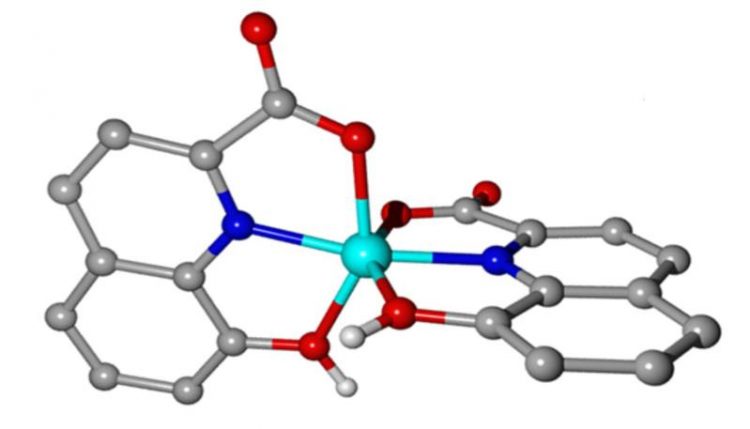Microbial colonization measures

Iron is important for every organism. In animals and humans, it controls hematosis and oxygen transport. However, iron ions also influence the community of microorganisms in the gut, the so-called microbiome.
Gut bacteria require iron ions to grow and proliferate, and now scientists at the Max Planck Institute for Chemical Ecology in Jena, Germany, have provided evidence that insects of the Noctuidae family produce a substance in their gut tissue, an aromatic quinoline carboxylic acid, that binds iron ions, thus directly controlling the growth of gut microbes.
The control of iron availability in the gut is probably a widespread principle. The active biosynthesis of an iron chelator, a substance that binds iron, has now been confirmed in an insect for the first time. (Organic & Biomolecular Chemistry, November 2014).
Chemical substances that bind iron ions are called iron chelators. An example of such an iron chelator is an aromatic quinoline carboxylic acid (8-hydroquinoline-2-carboxylic acid, or 8-HQA). Large numbers of 8-HQA molecules are found in the guts of Spodoptera larvae (Noctuidae) where, together with iron ions, they form a complex, one result of which is that there are fewer freely available iron ions. Because gut bacteria need iron for growth, the absence of 8-HQA directly influences the gut microflora.
Researchers have long been baffled by the enormous metabolic effort insects put into the biosynthesis of 8-HQA: Approximately 10% of tryptophan, an essential amino acid caterpillars ingest when they feed on plants, is converted into 8-HQA over an insect’s life cycle. The substance is formed in the tissue of the insect gut, however, it is not produced by gut bacteria.
“The effect on the gut microbiome is achieved by the fact that iron ions, which are necessary for microbial growth, are no longer available. For example, E. coli stops growing completely in the presence of typical 8-HQA concentrations in the gut. Only if iron ions are added, the bacteria restart growth,” said Wilhelm Boland, director of the Department of Bioorganic Chemistry.
Controlling iron availability is an extremely important mechanism for manipulating bacterial growth in microhabitats, such as animal guts where these bacteria live. Proof that a substance which controls iron is actively synthesized in the guts of Spodoptera larvae suggests that similar mechanisms likely also exist in other animals. [AO]
Original Publication:
Pesek, J., Svoboda, J., Sattler, M., Bartram, S., Boland, W. (2014). Biosynthesis of 8-hydroxyquinoline-2-carboxylic acid, an iron chelator from the gut of the lepidopteran Spodoptera littoralis. Organic & Biomolecular Chemistry. doi: 10.1039/c4ob01857e.
http://dx.doi.org/10.1039/c4ob01857e
Further Information:
Prof. Dr. Wilhelm Boland, Max Planck Institute for Chemical Ecology, e-mail boland@ice.mpg.de, Tel.: +49 3641 57 1201
Weitere Informationen:
Media Contact
All latest news from the category: Life Sciences and Chemistry
Articles and reports from the Life Sciences and chemistry area deal with applied and basic research into modern biology, chemistry and human medicine.
Valuable information can be found on a range of life sciences fields including bacteriology, biochemistry, bionics, bioinformatics, biophysics, biotechnology, genetics, geobotany, human biology, marine biology, microbiology, molecular biology, cellular biology, zoology, bioinorganic chemistry, microchemistry and environmental chemistry.
Newest articles

Properties of new materials for microchips
… can now be measured well. Reseachers of Delft University of Technology demonstrated measuring performance properties of ultrathin silicon membranes. Making ever smaller and more powerful chips requires new ultrathin…

Floating solar’s potential
… to support sustainable development by addressing climate, water, and energy goals holistically. A new study published this week in Nature Energy raises the potential for floating solar photovoltaics (FPV)…

Skyrmions move at record speeds
… a step towards the computing of the future. An international research team led by scientists from the CNRS1 has discovered that the magnetic nanobubbles2 known as skyrmions can be…





















